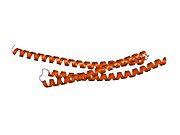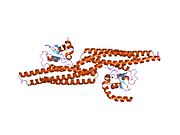- Diablo homolog
-
Diablo homolog, mitochondrial is a protein that in humans is encoded by the DIABLO gene (direct IAP binding protein with low pI).[1][2][3] DIABLO is also referred to as second mitochondria-derived activator of caspases or SMAC.
Contents
Function
SMAC is a mitochondrial protein that promotes cytochrome-c dependent activation by eliminating the inhibition via IAP - a protein that negatively regulates apoptosis or programmed cell death.[4] Smac is normally a mitochondrial protein but is found in the cytosol when a cell is primed for apoptosis by the final execution step of caspase activation. Smac is the second protein in the apoptosis link, along with cytochrome c, that promotes apoptosis by activating caspases.
SMAC is an inhibitor of apoptosis protein (IAP)-binding protein. This mitochondrial protein enters the cytosol when cells undergo apoptosis, and it moderates the caspase inhibition of IAPs.
Gene
Multiple polyadenylation sites have been found for this gene. Several alternatively spliced transcript variants that encode distinct isoforms have been described for this gene but the validity of some transcripts, and their predicted ORFs, has not been determined conclusively.[3]
Interactions
Diablo homolog has been shown to interact with Lymphotoxin beta receptor,[5] Survivin,[6] XIAP[6][7][8][9][10] and BIRC2.[9][11]
References
- ^ McNeish IA, Bell S, McKay T, Tenev T, Marani M, Lemoine NR (May 2003). "Expression of Smac/DIABLO in ovarian carcinoma cells induces apoptosis via a caspase-9-mediated pathway". Exp Cell Res 286 (2): 186–98. doi:10.1016/S0014-4827(03)00073-9. PMID 12749848.
- ^ Yu J, Wang P, Ming L, Wood MA, Zhang L (Jun 2007). "SMAC/Diablo mediates the proapoptotic function of PUMA by regulating PUMA-induced mitochondrial events". Oncogene 26 (29): 4189–98. doi:10.1038/sj.onc.1210196. PMID 17237824.
- ^ a b "Entrez Gene: DIABLO diablo homolog (Drosophila)". http://www.ncbi.nlm.nih.gov/sites/entrez?Db=gene&Cmd=ShowDetailView&TermToSearch=56616.
- ^ Vucic D, Deshayes K, Ackerly H, Pisabarro MT, Kadkhodayan S, Fairbrother WJ, Dixit VM (April 2002). "SMAC negatively regulates the anti-apoptotic activity of melanoma inhibitor of apoptosis (ML-IAP)". J. Biol. Chem. 277 (14): 12275–9. doi:10.1074/jbc.M112045200. PMID 11801603.
- ^ Kuai, Jun; Nickbarg Elliott, Wooters Joe, Qiu Yongchang, Wang Jack, Lin Lih-Ling (Apr. 2003). "Endogenous association of TRAF2, TRAF3, cIAP1, and Smac with lymphotoxin beta receptor reveals a novel mechanism of apoptosis". J. Biol. Chem. (United States) 278 (16): 14363–9. doi:10.1074/jbc.M208672200. ISSN 0021-9258. PMID 12571250.
- ^ a b Song, Zhiyin; Yao Xuebiao, Wu Mian (Jun. 2003). "Direct interaction between survivin and Smac/DIABLO is essential for the anti-apoptotic activity of survivin during taxol-induced apoptosis". J. Biol. Chem. (United States) 278 (25): 23130–40. doi:10.1074/jbc.M300957200. ISSN 0021-9258. PMID 12660240.
- ^ Hunter, Allison M; Kottachchi Dan, Lewis Jennifer, Duckett Colin S, Korneluk Robert G, Liston Peter (Feb. 2003). "A novel ubiquitin fusion system bypasses the mitochondria and generates biologically active Smac/DIABLO". J. Biol. Chem. (United States) 278 (9): 7494–9. doi:10.1074/jbc.C200695200. ISSN 0021-9258. PMID 12511567.
- ^ Davoodi, Jamshid; Lin Lily, Kelly John, Liston Peter, MacKenzie Alexander E (Sep. 2004). "Neuronal apoptosis-inhibitory protein does not interact with Smac and requires ATP to bind caspase-9". J. Biol. Chem. (United States) 279 (39): 40622–8. doi:10.1074/jbc.M405963200. ISSN 0021-9258. PMID 15280366.
- ^ a b Verhagen, A M; Ekert P G, Pakusch M, Silke J, Connolly L M, Reid G E, Moritz R L, Simpson R J, Vaux D L (Jul. 2000). "Identification of DIABLO, a mammalian protein that promotes apoptosis by binding to and antagonizing IAP proteins". Cell (UNITED STATES) 102 (1): 43–53. doi:10.1016/S0092-8674(00)00009-X. ISSN 0092-8674. PMID 10929712.
- ^ Verhagen, Anne M; Silke John, Ekert Paul G, Pakusch Miha, Kaufmann Hitto, Connolly Lisa M, Day Catherine L, Tikoo Anjali, Burke Richard, Wrobel Carolyn, Moritz Robert L, Simpson Richard J, Vaux David L (Jan. 2002). "HtrA2 promotes cell death through its serine protease activity and its ability to antagonize inhibitor of apoptosis proteins". J. Biol. Chem. (United States) 277 (1): 445–54. doi:10.1074/jbc.M109891200. ISSN 0021-9258. PMID 11604410.
- ^ Hegde, Ramesh; Srinivasula Srinivasa M, Datta Pinaki, Madesh Muniswamy, Wassell Richard, Zhang ZhiJia, Cheong NaEun, Nejmeh Julie, Fernandes-Alnemri Teresa, Hoshino Shin-ichi, Alnemri Emad S (Oct. 2003). "The polypeptide chain-releasing factor GSPT1/eRF3 is proteolytically processed into an IAP-binding protein". J. Biol. Chem. (United States) 278 (40): 38699–706. doi:10.1074/jbc.M303179200. ISSN 0021-9258. PMID 12865429.
Further reading
- Shi Y (2001). "A structural view of mitochondria-mediated apoptosis.". Nat. Struct. Biol. 8 (5): 394–401. doi:10.1038/87548. PMID 11323712.
- Anguiano-Hernandez YM, Chartier A, Huerta S (2007). "Smac/DIABLO and colon cancer.". Anti-cancer agents in medicinal chemistry 7 (4): 467–73. doi:10.2174/187152007781058631. PMID 17630921.
- Maruyama K, Sugano S (1994). "Oligo-capping: a simple method to replace the cap structure of eukaryotic mRNAs with oligoribonucleotides.". Gene 138 (1–2): 171–4. doi:10.1016/0378-1119(94)90802-8. PMID 8125298.
- Bonaldo MF, Lennon G, Soares MB (1997). "Normalization and subtraction: two approaches to facilitate gene discovery". Genome Res. 6 (9): 791–806. doi:10.1101/gr.6.9.791. PMID 8889548.
- Hillier LD, Lennon G, Becker M et al. (1997). "Generation and analysis of 280,000 human expressed sequence tags". Genome Res. 6 (9): 807–28. doi:10.1101/gr.6.9.807. PMID 8889549.
- Suzuki Y, Yoshitomo-Nakagawa K, Maruyama K et al. (1997). "Construction and characterization of a full length-enriched and a 5'-end-enriched cDNA library". Gene 200 (1–2): 149–56. doi:10.1016/S0378-1119(97)00411-3. PMID 9373149.
- Du C, Fang M, Li Y et al. (2000). "Smac, a mitochondrial protein that promotes cytochrome c-dependent caspase activation by eliminating IAP inhibition". Cell 102 (1): 33–42. doi:10.1016/S0092-8674(00)00008-8. PMID 10929711.
- Verhagen AM, Ekert PG, Pakusch M et al. (2000). "Identification of DIABLO, a mammalian protein that promotes apoptosis by binding to and antagonizing IAP proteins". Cell 102 (1): 43–53. doi:10.1016/S0092-8674(00)00009-X. PMID 10929712.
- Srinivasula SM, Datta P, Fan XJ et al. (2000). "Molecular determinants of the caspase-promoting activity of Smac/DIABLO and its role in the death receptor pathway". J. Biol. Chem. 275 (46): 36152–7. doi:10.1074/jbc.C000533200. PMID 10950947.
- Chai J, Du C, Wu JW et al. (2000). "Structural and biochemical basis of apoptotic activation by Smac/DIABLO". Nature 406 (6798): 855–62. doi:10.1038/35022514. PMID 10972280.
- Liu Z, Sun C, Olejniczak ET et al. (2001). "Structural basis for binding of Smac/DIABLO to the XIAP BIR3 domain". Nature 408 (6815): 1004–8. doi:10.1038/35050006. PMID 11140637.
- Wu G, Chai J, Suber TL et al. (2001). "Structural basis of IAP recognition by Smac/DIABLO". Nature 408 (6815): 1008–12. doi:10.1038/35050012. PMID 11140638.
- Srinivasula SM, Hegde R, Saleh A et al. (2001). "A conserved XIAP-interaction motif in caspase-9 and Smac/DIABLO regulates caspase activity and apoptosis". Nature 410 (6824): 112–6. doi:10.1038/35065125. PMID 11242052.
- Huang Y, Park YC, Rich RL et al. (2001). "Structural basis of caspase inhibition by XIAP: differential roles of the linker versus the BIR domain". Cell 104 (5): 781–90. doi:10.1016/S0092-8674(01)00273-2. PMID 11257231.
- Roberts DL, Merrison W, MacFarlane M, Cohen GM (2001). "The Inhibitor of Apoptosis Protein-Binding Domain of Smac Is Not Essential for Its Proapoptotic Activity". J. Cell Biol. 153 (1): 221–8. doi:10.1083/jcb.153.1.221. PMC 2185525. PMID 11285287. http://www.pubmedcentral.nih.gov/articlerender.fcgi?tool=pmcentrez&artid=2185525.
- Verhagen AM, Silke J, Ekert PG et al. (2002). "HtrA2 promotes cell death through its serine protease activity and its ability to antagonize inhibitor of apoptosis proteins". J. Biol. Chem. 277 (1): 445–54. doi:10.1074/jbc.M109891200. PMID 11604410.
- Adrain C, Creagh EM, Martin SJ (2002). "Apoptosis-associated release of Smac/DIABLO from mitochondria requires active caspases and is blocked by Bcl-2". EMBO J. 20 (23): 6627–36. doi:10.1093/emboj/20.23.6627. PMC 125329. PMID 11726499. http://www.pubmedcentral.nih.gov/articlerender.fcgi?tool=pmcentrez&artid=125329.
- Sun XM, Bratton SB, Butterworth M et al. (2002). "Bcl-2 and Bcl-xL inhibit CD95-mediated apoptosis by preventing mitochondrial release of Smac/DIABLO and subsequent inactivation of X-linked inhibitor-of-apoptosis protein". J. Biol. Chem. 277 (13): 11345–51. doi:10.1074/jbc.M109893200. PMID 11801595.
PDB gallery Categories:- Human proteins
- Chromosome 12 gene stubs
Wikimedia Foundation. 2010.




